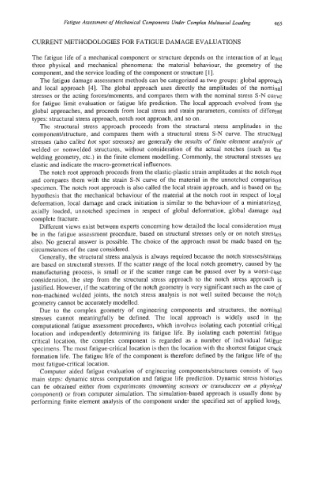Page 481 - Biaxial Multiaxial Fatigue and Fracture
P. 481
Fatigue Assessment of Mechanical Components Under Complex Multiaxial Loading 465
CURRENT METHODOLOGIES FOR FATIGUE DAMAGE EVALUATIONS
The fatigue life of a mechanical component or structure depends on the interaction of at least
three physical and mechanical phenomena: the material behaviour, the geometry of the
component, and the service loading of the component or structure [I].
The fatigue damage assessment methods can be categorized as two groups: global approach
and local approach [4]. The global approach uses directly the amplitudes of the nominal
stresses or the acting forces/moments, and compares them with the nominal stress S-N curve
for fatigue limit evaluation or fatigue life prediction. The local approach evolved from the
global approaches, and proceeds from local stress and strain parameters, consists of different
types: structural stress approach, notch root approach, and so on.
The structural stress approach proceeds from the structural stress amplitudes in the
component/structure, and compares them with a structural stress S-N curve. The structural
stresses (also called hot spot stresses) are generally the results of finite element analysis of
welded or nonwelded structures, without consideration of the actual notches (such as the
welding geometry, etc.) in the finite element modelling. Commonly, the structural stresses are
elastic and indicate the macro-geometrical influences.
The notch root approach proceeds from the elastic-plastic strain amplitudes at the notch root
and compares them with the strain S-N curve of the material in the unnotched comparison
specimen. The notch root approach is also called the local strain approach, and is based on the
hypothesis that the mechanical behaviour of the material at the notch root in respect of local
deformation, local damage and crack initiation is similar to the behaviour of a miniaturized,
axially loaded, unnotched specimen in respect of global deformation, global damage and
complete fracture.
Different views exist between experts concerning how detailed the local consideration must
be in the fatigue assessment procedure, based on structural stresses only or on notch stresses
also. No general answer is possible. The choice of the approach must be made based on the
circumstances of the case considered.
Generally, the structural stress analysis is always required because the notch stresses/strains
are based on structural stresses. If the scatter range of the local notch geometry, caused by the
manufacturing process, is small or if the scatter range can be passed over by a worst-case
consideration, the step from the structural stress approach to the notch stress approach is
justified. However, if the scattering of the notch geometry is very significant such as the case of
non-machined welded joints, the notch stress analysis is not well suited because the notch
geometry cannot be accurately modelled.
Due to the complex geometry of engineering components and structures, the nominal
stresses cannot meaningfully be defined. The local approach is widely used in the
computational fatigue assessment procedures, which involves isolating each potential critical
location and independently determining its fatigue life. By isolating each potential fatigue
critical location, the complex component is regarded as a number of individual fatigue
specimens. The most fatigue-critical location is then the location with the shortest fatigue crack
formation life. The fatigue life of the component is therefore defined by the fatigue life of the
most fatigue-critical location.
Computer aided fatigue evaluation of engineering components/structures consists of two
main steps: dynamic stress computation and fatigue life prediction. Dynamic stress histories
can be obtained either from experiments (mounting sensors or transducers on a physical
component) or from computer simulation. The simulation-based approach is usually done by
performing finite element analysis of the component under the specified set of applied loads.

